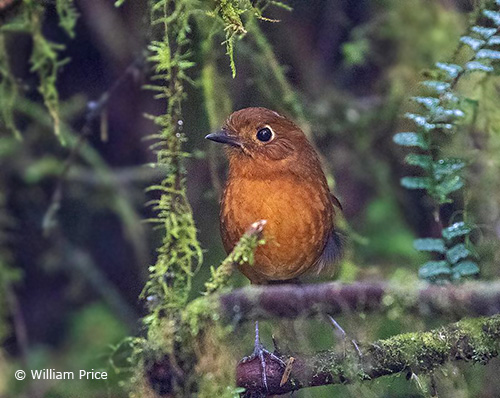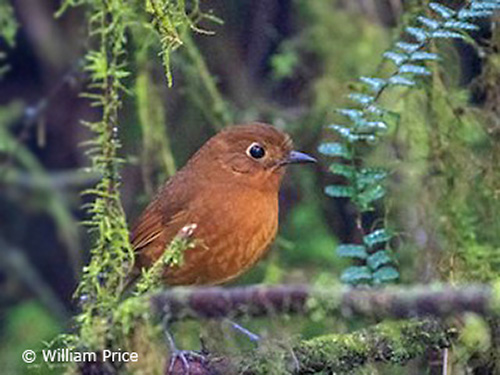
Fr: Grallaire de Junin
Ang: Junin Antpitta
All: Junínameisenpitta
Esp: Tororoi de Junin
Nd: Junínmierpitta
Sd: junínmyrpitta
Photographer:
William Price
PBase-tereksandpiper & Flickr William Price
Text by Nicole Bouglouan
Sources:
HANDBOOK OF THE BIRDS OF THE WORLD Vol 8 By Josep del Hoyo-Andrew Elliott-David Christie - Lynx Edicions - ISBN: 8487334504
BIRDS OF SOUTH AMERICA – Passerines - by Robert S. Ridgely and Guy Tudor – HELM Field Guides – ISBN: 9781408113424
The breeding biology of Grallaria and Grallaricula antpittas
Antpitta’s: the secretive birds of the South-American forest!
Fatbirder - Grallariidae – Antpittas
CREAGUS@Monterey Bay (Don Roberson)
Wikipedia, the free encyclopaedia
Wikipedia, la enciclopedia libre
Junin Antpitta
Grallaria obscura
Passeriformes Order – Grallariidae Family
INTRODUCTION:
Like the Puno Antpitta and several others, the Junin Antpitta was formerly a subspecies of the Rufous Antpitta (G. rufula). It was recognized as a full species in 2021 by some authors.
The name of the species refers to the Department of Junín, Peru, where it occurs as endemic species. It is found on the eastern slope of the Peruvian Andes in this department.
The Junin Antpitta frequents the humid montane forests with moss and epiphytes. It forages on the ground by hopping quickly on the forest floor. Its diet includes arthropods, earthworms and various invertebrates.
The breeding behaviour is currently unknown, but it is probably quite similar to that of other closely related species.
The Junin Antpitta has very restricted range, and locally, many areas are impacted by grazing, burning and agriculture. The species is not completely recognized as a full species and the status is unknown.
DESCRIPTION OF THE BIRD:
Biometrics:
Length: 14-15 cm
The Junin Antpitta is a plump, long-legged and short-tailed species.
The plumage is dark reddish yellow-brown on crown, upperparts, wings and tail. On the upperwing, the flight-feathers are darker brown with pale edges. The alula and some primary wing-coverts are slightly darker too.

On the underparts, throat and breast are reddish yellow-brown with indistinct, vertical paler markings. The belly is paler with whitish to pale buff centre and undertail-coverts. We can see some pale buff feathers on the flanks.
The head is dark reddish-yellow-brown on crown and ear-coverts, whereas the malar area appears slightly paler.
The bill is black. The feathers around the base of the bill are often slightly ruffled, similar and probably used as rictal bristles.
The eyes are dark brown, surrounded by pale buff eyering, slightly broader on the rear eye.
Long legs and feet are pale blue-grey.
Male and female are similar.
The juvenile is not currently described.
RANGE:
The Junin Antpitta occurs on the east slope of the Andes of C Peru. The species is confined to the Department of Junín, S of Río Perené and Río Paucartambo, and N of Río Mantano and W of Río Ene.
HABITAT:
The Junin Antpitta frequents the humid montane forest with heavy moss and epiphytes, and large patches of Chusquea bamboo in the understory. The bird hops on the forest floor while foraging.
The species can be seen at high elevations, from 3,000 to 3,600 metres.

CALLS AND SONGS: SOUNDS BY XENO-CANTO
The Junin Antpitta gives a slow series of buzzy notes, slowing in pitch towards the end. It is usually uttered once or with long intervals. It is named “Long song”.
But this species also gives a “Short song”, a modulated two-note song at regular pitch, starting by a single, abrupt note, followed by a much longer buzzy note. It is described as “p’breeeeer”. It is often given for long periods, with one song every 3-15 seconds. This song is the main vocalization of the species.
It sings mostly at dawn, from low perch or from the ground.
BEHAVIOUR IN THE WILD:
The Junin Antpitta has terrestrial habits. It forages by hopping quickly along the forest floor. It stops to return dead leaves with the bill, or to probe the soft soil while searching for prey.
Like other Grallaria species, it is suspected to feed on arthropods, earthworms and various other invertebrates.
The breeding biology of the Junin Antpitta is currently unknown. However, it is probably very similar to the breeding behaviour of other Grallaria species.
The nests are usually an open cup-shaped structure, built less than three meters above the ground. Both male and female share the nesting duties.
The Junin Antpitta is presumably sedentary within its restricted range.
Like numerous members of the genus Grallaria, the Junin Antpitta is probably reluctant to fly. When alarmed, it prefers to run into the nearby vegetal cover or if necessary, to make a short flight to reach the nearest vegetation.


REPRODUCTION OF THIS SPECIES:
The Junin Antpitta probably breeds when the food resources are available.
The breeding biology of this species is currently unknown.
The members of the genus Grallaria build a cup-shaped nest often against a tree trunk used as support, or against smaller supports such as epiphytes or vine tangles. The nest is made of sticks, leaf material or moss, depending on the species. it is placed about three metres above the ground.
The female generally lays two bluish-green eggs, sometimes with darker markings. The incubation usually lasts 17-21 days shared by both parents. The chicks are fed with earthworms and arthropods, also by both adults. The nestlings have bright orange mouth lining and cloaca. They usually fledge 15-19 days after hatching.
More information is needed concerning the breeding biology of the Junin Antpitta.
PROTECTION / THREATS / STATUS:
The Junin Antpitta is not currently recognized by the IUCN, and it is still treated as subspecies of Grallaria rufula.
It is suspected to occur in two protected areas, the Area de Conservación Regional Huaytapallana (HFG) and the Bosque de Protección Pui Pui.
Its range is relatively intact, although local areas are heavily impacted by grazing, burning and agriculture.
The status of the Junin Antpitta is currently unknown.